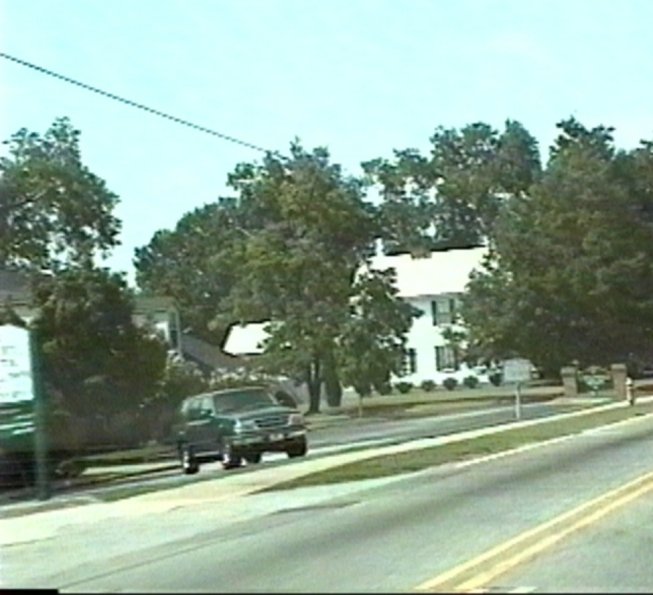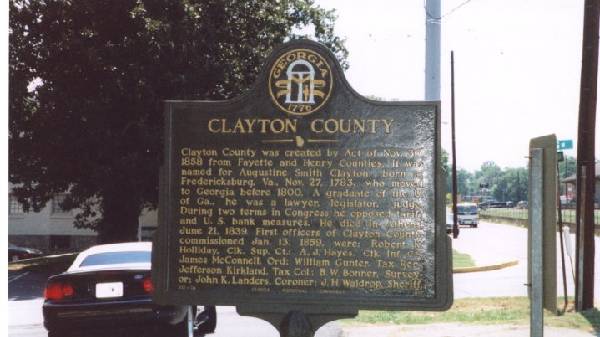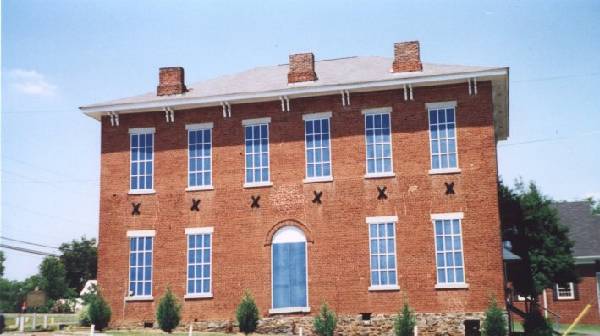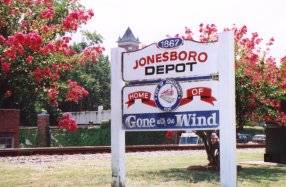Jonesboro
 Built
in 1840, this house was enlarged and remodelled in 1859 when John's Aunt
Martha and Uncle James Johnson moved there from Fayetteville. This
side view does not show the two-story classical columns of this beautiful
antebellum house. During the Civil War it was used as a Confederate
Commissary and Union field hospital. J. F. Johnson, was a member of
the Georgia Legislature and a signer of the Georgia Secession Ordinance. Built
in 1840, this house was enlarged and remodelled in 1859 when John's Aunt
Martha and Uncle James Johnson moved there from Fayetteville. This
side view does not show the two-story classical columns of this beautiful
antebellum house. During the Civil War it was used as a Confederate
Commissary and Union field hospital. J. F. Johnson, was a member of
the Georgia Legislature and a signer of the Georgia Secession Ordinance.
 Clayton County was created by Act of November 30th 1858 from Fayette
and Henry Counties. It was named for Augustine Smith
Clayton. Amongst the first officers of Clayton County,
commissioned January 13th 1859, was Robert K. Holliday, as Clark to the
Supreme Court. This is John's Uncle Robert. Clayton County was created by Act of November 30th 1858 from Fayette
and Henry Counties. It was named for Augustine Smith
Clayton. Amongst the first officers of Clayton County,
commissioned January 13th 1859, was Robert K. Holliday, as Clark to the
Supreme Court. This is John's Uncle Robert.
 Situated at 144 N. McDonough Street, the old Courthouse was built on
the stone foundations of the original Court House of 1861, which was
burned by Union troops in August 1864. Commissioned in 1859,
John's Uncle, Robert Holliday would have known this and the original
building. This building was in use from 1869 when the 'new'
Courthouse was built. Today it houses the Jonesboro Lodge of the
Free and Accepted Masons. Situated at 144 N. McDonough Street, the old Courthouse was built on
the stone foundations of the original Court House of 1861, which was
burned by Union troops in August 1864. Commissioned in 1859,
John's Uncle, Robert Holliday would have known this and the original
building. This building was in use from 1869 when the 'new'
Courthouse was built. Today it houses the Jonesboro Lodge of the
Free and Accepted Masons.
 The
old Jonesboro Depot (Railway Station) now houses 'The Road to Tara', Gone
with the Wind, museum. What does this have to do with John
Henry? Margaret Mitchell researched much of her book at the new
Courthouse building here in Jonesboro, (see the Gallery) and her
great-grandfather, Philip Fitzgerald, was uncle to Mary Ann Fitzgerald who
married Robert Kennedy Holliday, Aunt and Uncle to John Henry and parents
of Mattie Holliday, later Sister Mary Melanie.It is understood that
Margaret Mitchell based the characters of Gerald O'Hara and Melanie Wilkes
on Philip Fitzgerald and Sister Mary Melanie respectively. Could she
also have based Ashley Wilkes on John Henry? The
old Jonesboro Depot (Railway Station) now houses 'The Road to Tara', Gone
with the Wind, museum. What does this have to do with John
Henry? Margaret Mitchell researched much of her book at the new
Courthouse building here in Jonesboro, (see the Gallery) and her
great-grandfather, Philip Fitzgerald, was uncle to Mary Ann Fitzgerald who
married Robert Kennedy Holliday, Aunt and Uncle to John Henry and parents
of Mattie Holliday, later Sister Mary Melanie.It is understood that
Margaret Mitchell based the characters of Gerald O'Hara and Melanie Wilkes
on Philip Fitzgerald and Sister Mary Melanie respectively. Could she
also have based Ashley Wilkes on John Henry?
For more photos
and information about Jonesboro visit our gallery.
|